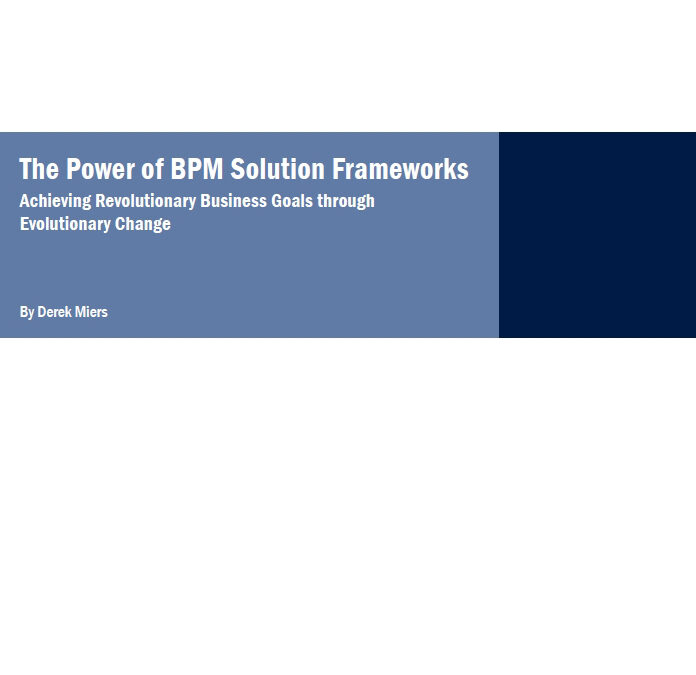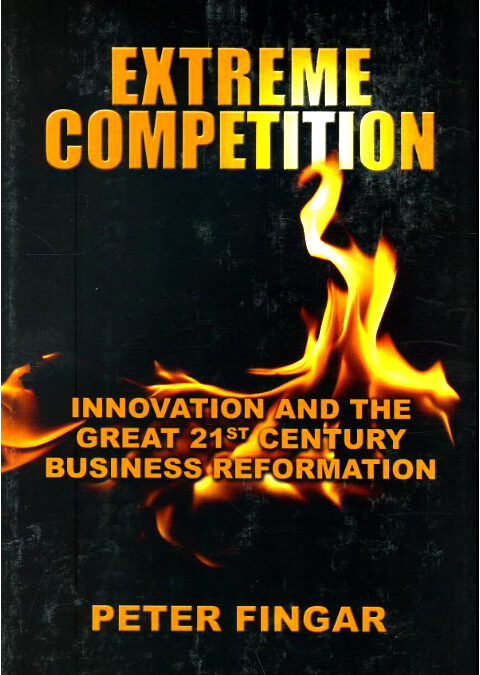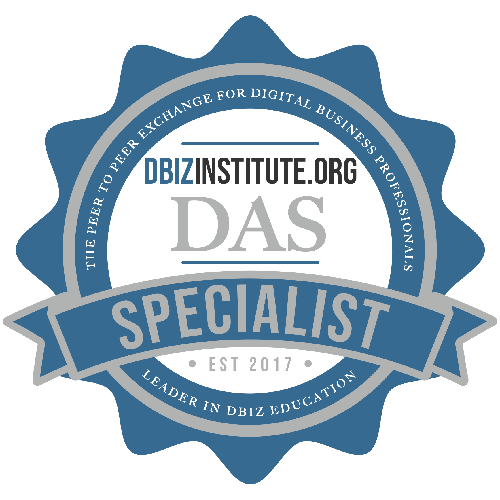Home / Resources
Resources
Discover a Wealth of BPM Knowledge and Expertise at BPMInstitute.org!
Selecting a BPMS
Dr. Bruce Silver is an independent industry analyst and consultant focused on business process management and content management technologies. He is the author of the 2006 BPMS Report series, evaluations of leading BPMS offerings available free through...

The FBI Launches a Major Business Process Reengineering Effort
Robert J. Garrity Jr., a 29-year veteran of the Federal Bureau of Investigation, is no stranger to solving intricate information infrastructure issues.

When You Say “Process,” You Mean…?
Inside organizations that are doing various kinds of process “work”-whether improvement projects, technology enhancements or process definition and documentation—we often hear a lot of confusion and frustration because people sometimes mean different things when they use the word “process.” The most common frustration happens when two people are talking at different “levels” of process—with one person perhaps talking about a big end-to-end process such as order fulfillment while the other person is talking about a single task but one with multiple steps and considerable complexity—yet both are

BPMS Watch: What BPMS Can Learn from Business Rule Management
One of the core promises of BPMS is that it lets process owners on the business side model, monitor, and maintain their own process implementations. While chronically backlogged IT is hypersensitive to the charge that they take too long to respond to the changing demands of business, it still resists ceding to the business the power to maintain business process solutions themselves, much less build them from scratch. In fact, for many architects and developers the mere suggestion of business-driven implementation taints the whole BPMS concept.
BPM Outside the Firewall
In July 2006, BPMInstitute.org initiated a survey of its 24,000 member community to gain an understanding of how enterprises across a range of industries are pursuing business process innovation and improvement and to what degree these activities are strategically aligned to the companies’ business transformation and growth objectives.
This webcast – the second in a five-part series – will review the findings of the survey, with a specific focus on the issues, challenges and solutions associated with extending business processes outside the firewall to customers, partners and suppliers.

SOA Adoption Should Stimulate Demand for BPM, BAM and BRM
In today's environment, business dynamics and technological innovations have left organizations with a disparate mix of operating systems, applications and databases. This makes it difficult, time-consuming and costly for IT departments to deliver new applications...

Towards Business Rule Stewardship and Governance
Corporate adopters of a business rules approach over the past decade have often been limited to individual projects within an organization. It was not surprising to find disparate (either geographically or functionally) areas of the same company initiating independent efforts often resulting in a completely different methodology for applying business rules – and in some cases with different business rule management software. The latest generation of business rule software has, however, been created with the enterprise perspective in mind.
Who, What and How of a Business Rules Analyst
In my first article, I emphasized the vitality of the role of an IT Business Analyst and how it is expanding due to business demands for high performance. Business Analysts identify the business needs of their clients and stakeholders to help determine solutions to business problems. They play a vital role throughout the project life cycle by understanding and representing stakeholder needs, documenting and organizing the requirements for a system, and communicating requirements to an entire team.
Planning Process Change Effort for a Technology-driven Project
Whether developing and updating processes as an improvement initiative, in support of a software upgrade, as part of an automation effort or introduction of a new line business, it is important to identify the required work and to estimate the time, cost and resources required to achieve the desired goals. When the purpose of the project is to develop or improve a process, it is easy to see why a project plan to identify the tasks, milestones, resources and timelines is required.

Business Process, Business Rules and the Agile Enterprise
Business Process Management and Business Rules Approaches (BPM/BR) are agility technologies. Yet, for most early adopters they are the last step in inoculating agility into an organization. First business, government and non-profit organizations must identify and recognize a challenge arising from changes in demand, missions and charters. Next the challenge must be incorporated into a project portfolio then lastly carried out.

The ‘A’ in SOA is for Architecture
Are you confused about the term service-oriented architecture? Is the lack of a formal definition of SOA causing governance issues within your organization? You’re not alone.
An Innovation Discipline Model
Chicago-based Doblin, Inc. is an internationally recognized innovation strategy firm. Doblin’s staff is composed primarily of business strategists, cultural anthropologists, contextual researchers, design planners and information designers. Doblin is well known for its proprietary innovation landscape diagnostic tool, which is used to identify patterns of innovation within an industry. This article explores Doblin’s approach to treating innovation as a repeatable business discipline.
Viewing SOA from Various Perspectives
Often when I start discussing SOA, a story comes to my mind that I first heard from my grand father when I was kid. It is about six blind men who encounter an elephant for the first time in their life. They perceive the animal differently and start fighting amongst themselves. One who touched its tail thought it was a snake, another who got hold of his trunk thought it to be a tree branch, the third, bumping against his rigid body, thought it was a wall while the fourth, getting hold of his legs, thought it to be a log of wood and so on.

The Power of BPM Solution Frameworks: Achieving Revolutionary Objectives through Evolutionary Change
More Value, Less Risk. Solution frameworks are customizable solutions that provide the building blocks for organization-specific applications. This approach enables organizations to reach the point of value more quickly, with lower risk. Solution frameworks, combined with an iterative improvement methodology, allow organizations to embrace change. In order to reduce the time-to-value, many vendors supply process “templates” that show how their product can support a given business or industry problem.
Case Study: The Value of Transforming Your Business to a Process-driven Enterprise
Unisen is a leading provider of Business Process Outsourcing and Information Technology Outsourcing to the Canadian fund industry. Unisen services about 47% of the mutual fund companies in Canada. There are over 1.3 million calls into the call center and the company administers $40 billion of AUA for institutional and offshore clients. Unisen process almost 5 million investor statements representing 15 million pages of output.
Unisen is a leading provider of Business Process Outsourcing and Information Technology Outsourcing to the Canadian fund industry. Unisen services about 47% of the mutual fund companies in Canada. There are over 1.3 million calls into the call center and the company administers $40 billion of AUA for institutional and offshore clients. Unisen process almost 5 million investor statements representing 15 million pages of output.
The scope of services Unisen provides for information technology includes:

The Innovation Imperative Part 2 of 3
In Part 1 of this three-part introduction to business innovation, we explored the innovation imperative and concluded by identifying six facets of business innovation:
- Operational innovation
- Organizational innovation
- Supply-side innovation
- Core-competency innovation
- Sell-side innovation
- Product and Service innovation.
Now, let’s take a quick look at each of these categories of business innovation.

Can the Business Rule?
“It is not the strongest of the species that survive, nor the most intelligent,
but the one most responsive to change,” said Charles Darwin.

EA, BPM and SOA Convergence
Many strategic initiatives today are focused on Enterprise Architecture (EA) development, Business Process Management (BPM) and Service-Oriented Architecture (SOA) development. In support of these important activities are numerous approaches, techniques, tools and experienced consultants. You can also find a wealth of information on the web and in various industry newsletters and publications. Let us take a look at what is common and shared between these essential initiatives.

Build your SOA: Maturity and Methodology, Part III
Introduction
Typical SOA initiatives can potentially suffer from one or more of the following problems:
You need an adaptable software methodology — a systematic approach to the way software is developed — that can provide rigid controls and processes during the initial SOA rollout b
What Makes a Process Slow?
Every organization believes there is additional speed that can be squeezed from its core processes. Are all processes then inherently slower than they should be? If so, what slows a process down?
There are many reasons in which a process will perform slower than it could. Here are some of the key reasons I have observed over a number of years that will put the brakes on a process:
Handoffs
Handoffs between departments in an organization have a significant impact on process performance.













